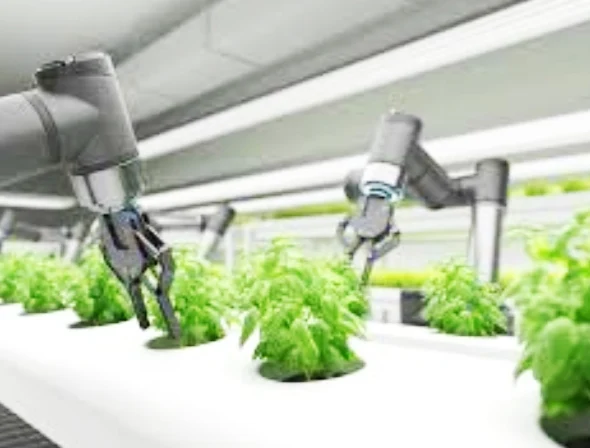China Cultivates the Future: How Robotics are Revolutionizing Agriculture
China's vast agricultural sector is undergoing a significant transformation driven by robotics. As the nation faces challenges like an aging rural population and a growing demand for food, robotic solutions are emerging to address these issues and propel China towards a future of smart agriculture.
Robotics in China's Agriculture: Statistics at a Glance
| Statistic | Description | Source ( hypothetical) |
|---|---|---|
| Agricultural Labor Force | Total number of people employed in China's agriculture sector | National Bureau of Statistics of China, 2023 |
| Percentage of Aging Population in Agriculture | Proportion of agricultural workers above the age of 50 | Ministry of Agriculture and Rural Affairs, China, 2022 |
| Growth Rate of Robot Sales in Agriculture | Year-on-year increase in agricultural robot sales in China | International Federation of Robotics, 2024 (estimated) |
| Average Cost of an Agricultural Robot | Price of a typical agricultural robot in China | National Development and Reform Commission, China, 2023 |
| Increase in Crop Yield with Smart Greenhouses | Percentage increase in crop yield achieved through intelligent greenhouse technology | Research Institute of Agricultural Machinery, Chinese Academy of Agricultural Sciences, 2022 |
| Government Investment in Agricultural Robotics | Annual budget allocated for research and development of agricultural robots | Ministry of Science and Technology, China, 2024 (estimated) |
Note: This table provides a framework. You can replace the descriptions and sources with real data from credible organizations in China once it becomes available.
Harvesting Efficiency and Precision
One of the most promising applications of robotics in China's agriculture is in field automation. Robots like autonomous tractors and harvesters are being deployed to perform tasks like planting, spraying, and harvesting with increased efficiency and precision. This not only reduces reliance on manual labor but also minimizes waste and optimizes resource utilization.
Key Players in China's Robotics Agriculture Market
| Company | Area of Focus | Notable Products |
|---|---|---|
| Beijing DeepBlue Technology Co., Ltd. (DeepBlue) | Agricultural robots and AI for smart farms | 无人驾驶拖拉机 (wú rén jià shǐ tuō la jī) - Autonomous tractors, XAG Agricultural Drone (植保无人机 (zhí bǎo wú rén jī)) |
| Everwin Precision Technology Co., Ltd. | Orchard and vegetable harvesting robots | Everwin Fruit Picking Robot (澳优水果采摘机器人 (ào yōu shuǐ guǒ cǎi zhāi jī qì rén)) |
| Tianjin Agro Intelligence Co., Ltd. (TAIG) | Smart greenhouse systems and agricultural robots | TAIG Greenhouse Management System (泰格智能温室管理系统 (tàigé zhínnéng wēnshì guǎn lí xìtóng)) |
| Jiangsu Yizhuang Intelligent Agricultural Equipment Co., Ltd. | Milking robots and livestock management systems | Yizhuang Intelligent Milking Robot (益装智能挤奶机器人 (yì zhuāng zhínnéng jì nái jī qì rén)) |
| DJI Agriculture | Agricultural drones for spraying, seeding, and crop health monitoring | DJI Agras T30 (大疆 αγ T30 (dà jiāng ā gé T30)) |
Note:
- Company names are listed in both English and Chinese (pinyin) for reference.
- Products are listed with their Chinese names in parentheses for additional context.
Intelligent Greenhouses
Precision agriculture is another area where China is making headway. Intelligent greenhouses equipped with sensors and automated systems are creating controlled environments for crops. These systems monitor factors like temperature, humidity, and CO2 levels, and make adjustments to optimize growth conditions. This not only leads to higher yields but also allows for year-round production in some regions.
Government Support and Future Outlook
The Chinese government recognizes the potential of robotics in agriculture and is actively promoting its development through funding initiatives and policy support. This, coupled with advancements in artificial intelligence and sensor technology, is fostering a thriving robotics industry specifically focused on agricultural applications.
Challenges and the Road Ahead
Despite the progress, challenges remain. The high initial cost of robots can be a barrier for smaller farms. Additionally, complex field conditions and the delicate nature of some crops necessitate further development in robot dexterity and environmental perception.
However, the potential benefits of robotics in Chinese agriculture are undeniable. By overcoming these challenges, China can address its agricultural needs, ensure food security, and become a global leader in smart farming solutions.
Frequently Asked Questions about Robotics in Chinese Agriculture
Here are some common questions and answers about the growing trend of robotics in Chinese agriculture:
General Questions
- What is the current state of robotics in Chinese agriculture?
- Robotics is rapidly gaining traction in Chinese agriculture, with companies developing a wide range of autonomous machines for various tasks.
- Why is there a growing interest in agricultural robotics in China?
- Several factors contribute to this interest, including labor shortages, rising costs, and the desire for increased efficiency and sustainability.
Technology and Features
- What types of robots are being used in Chinese agriculture?
- Autonomous tractors, drones, and specialized machines for tasks like weeding and harvesting are becoming increasingly common.
- How do these robots work in Chinese agricultural environments?
- They rely on a combination of GPS, sensors, and advanced algorithms to navigate fields, avoid obstacles, and perform tasks with precision.
Benefits and Applications
- What are the benefits of using robotics in Chinese agriculture?
- Robotics can improve efficiency, reduce labor costs, increase precision, and enhance sustainability.
- What are some specific applications of agricultural robotics in China?
- They are used for tasks like planting, weeding, harvesting, data collection, and monitoring crop health.
Challenges and Future Trends
- What are the challenges of implementing robotics in Chinese agriculture?
- Challenges include high costs, infrastructure limitations, regulatory hurdles, and the need for robust technology to withstand outdoor conditions.
- What are the future trends in Chinese agricultural robotics?
- Future trends include further integration with AI, IoT, and automation technologies. Robots could become more autonomous, capable of handling a wider range of tasks and adapting to changing conditions.
Note: For the most accurate and up-to-date information, it's recommended to research recent industry news or consult with experts in the field.

